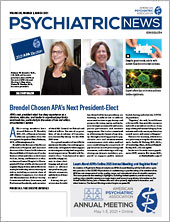Substance use disorders (SUDs) are prevalent in medically ill patient populations. The inclusion of consultation-liaison (C-L) psychiatrists in ambulatory settings via integration into primary care and specialty medicine clinics (including oncology, HIV, pain, diabetes, obstetrics and gynecology, and neurology) is increasing, so they are uniquely poised to provide care to the burgeoning number of patients with SUDs. In the coming years, a central goal of C-L psychiatrists should be to enhance the coordination of sophisticated treatment spanning different levels of care for larger numbers of patients.
Case Example
Mr. A is a 49-year-old single, anxious, unemployed man who lives with his parents. He presented to the hospital with acute alcoholic hepatitis and upon admission reported drinking a “fifth” of vodka daily for about 10 years. He said that his last drink was two days before his admission.
The C-L psychiatry service was asked to see him after he reported to the nursing staff that he was feeling very anxious and had seen “animals in the room.” He said that he had never experienced this before. The medical team administered fluids and electrolytes and initiated withdrawal management with benzodiazepines. The C-L psychiatrist recommended the addition of gabapentin as a foundation of withdrawal treatment.
Using open-ended questions and reflective listening to elicit his history, the consultant learned that the patient felt guilty about burdening his parents and was ready to consider doing something about his drinking if it meant he could maintain employment and support the household. He left the hospital after 48 hours and was prescribed gabapentin (600 mg three times a day) to support his attempt at sobriety. The patient agreed to follow up with primary care to continue the medication treatment and had a plan to attend a webinar-based Alcoholics Anonymous meeting the first evening after discharge.
Discussion
The National Institute on Alcohol Abuse and Alcoholism estimates that approximately 88,000 people die each year from alcohol-related causes in the United States, making it the third leading preventable cause of death. Thus, in Mr. A’s case, in addition to the critical first steps of treating patients for alcohol withdrawal syndrome in acute medical settings, C-L psychiatrists are critical to mitigating the high risk of relapse on alcohol upon discharge. Screening patients for underlying alcohol use disorder (AUD) and performing brief interventions, such as motivational interviewing (MI) to assess and enhance patients’ engagement, are foundational to the work. A simple, structured approach called SBIRT—Screening, Brief Intervention, and Referral to Treatment—has evidence of decreasing morbidity and mortality among patients seen in consultation. It helps patients move toward making a change for themselves and then connects them to community resources for continued treatment structured to fit their specific needs and preferences.
A common goal of MI is to engage patients in evidence-based treatment integrating outpatient counseling and medication-assisted treatment (MAT). For AUD, the options approved by the Food and Drug Administration (FDA) include naltrexone (oral and intramuscular), acamprosate, and disulfiram. Gabapentin may be used to manage withdrawal and then continued as part of an MAT regimen after discharge to good effect, especially in patients with comorbid anxiety disorders. When used in combination treatment with evidence-based substance counseling, MAT helps to reduce alcohol cravings and prevent relapse. C-L psychiatrists are well prepared to handle informed consent discussions that balance the risks and benefits of continued alcohol use against the risks and benefits of MAT, particularly in patients with impaired hepatic and renal functioning and other somatic maladies.
When consulted for opioid withdrawal, C-L psychiatrists can treat patients for the underlying opioid use disorder (OUD) during the active withdrawal phase and facilitate buprenorphine induction. This approach can be effective in managing the acute discomfort in hospital, emergency, and/or outpatient settings by starting a titration to maintenance treatment. The majority of studies of opioid addiction highlight the stabilizing role of MAT, specifically the FDA-approved MAT options for OUD: methadone, buprenorphine, and naltrexone.
An increasing number of community physicians (with psychiatric, family, pediatric, or internal medicine training) have started “bridge clinics” within their hospital systems where patients can be referred for initial stabilizing treatment before being connected with affordable long-term outpatient care. In addition to providing pharmacologic expertise to such programs, C-L psychiatrists also use their psychological and systems expertise to support individual recovery efforts and expand access to SUD treatment for more patients. They also play vital roles in prevention. C-L psychiatrists use consultative relationships to encourage distribution of the lifesaving opioid overdose reversal agent, naloxone, to patients, their families, and wider communities.
C-L psychiatrists treating patients with SUDs have the opportunity to use a “holistic” approach that improves short- and long-term outcomes, reduces morbidity and mortality, and enhances patient and clinician empowerment. In addition, C-L psychiatrists work collaboratively with other medical professionals to care for complex patients with SUDs and to prevent stigma from further compromising the health of this growing patient population. ■

